
Teaching Techniques
Applied Behavior Analysis (ABA)
A therapy based on the principles of behavior science
How it works
Focuses on improving specific behaviors (e.g., social skills, communication) through positive reinforcement.
Benefits
Proven to help build essential life skills and encourage desired behaviors.
Origin
Developed by Dr. Ivar Lovaas in the 1960s, ABA builds on B.F. Skinner's earlier work in behaviorism.
Primary Reference
Lovaas, O. I. (1987). Behavioral treatment and normal educational and intellectual functioning in young autistic children. Journal of Consulting and Clinical Psychology, 55(1), 3–9.
TEACCH (Treatment and Education of Autistic and Related Communication-Handicapped Children)
A structured teaching approach tailored to individuals with autism.
How it works
Emphasizes organization and visual clarity to accommodate the strengths and challenges of autism.
Benefits
Encourages independence by creating predictable routines and environments.
Origin
Developed in the 1970s by Dr. G Mesibov and Dr. Eric Schopler and colleagues at the University of North Carolina.
Primary Reference
Mesibov, G., & Schopler, E. (1994). TEACCH and autism program organization. Springer.
Picture Exchange Communication System (PECS)
A system using pictures to help individuals express needs and thoughts.
How it works
Starts with exchanging a picture for an item and progresses to more complex communication.
Origin
Created by Dr. Andrew Bondy and Lori Frost in 1985.
Benefits
Supports communication for non-verbal or minimally verbal children.
Primary Reference
Frost, L., & Bondy, A. (2002). The Picture Exchange Communication System Training Manual. Pyramid Educational Consultants.
Social Stories
Short, descriptive stories explaining social situations and expected behaviors.
How it works
Combines text and visuals to help children understand social cues and interactions.
Benefits
Prepares children for new or challenging situations and reduces anxiety.
Origin
Developed by Carol Gray in 1991 to assist individuals with autism.
Primary Reference
Gray, C. (1994). The New Social Story Book. Future Horizons.
Visual Supports
Tools like schedules, charts, and images to aid understanding and communication.
How it works
Breaks down information into visual elements for easier processing.
Benefits
Increases comprehension and independence.
Origin
While the use of visual aids has existed for decades, their formalization for autism support gained prominence through TEACCH and similar frameworks.
Primary Reference
Schopler, E., & Mesibov, G. (1995). Structured teaching in the TEACCH system. Springer.








